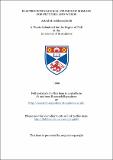Files in this item
Electrophysiological studies of memory for pictures and words
Item metadata
| dc.contributor.author | Schloerscheidt, Astrid M. | |
| dc.coverage.spatial | 241 p. | en_US |
| dc.date.accessioned | 2018-06-28T09:09:09Z | |
| dc.date.available | 2018-06-28T09:09:09Z | |
| dc.date.issued | 1999 | |
| dc.identifier.uri | https://hdl.handle.net/10023/14686 | |
| dc.description.abstract | The retrieval of information from explicit memory has been associated with three temporally and topographically dissociable ERP correlates, an early bilateral and late right frontal component as well as a left parietal effect. The three studies in this thesis investigated that material-specificity of these ERP old/new effects to address the question whether the ERP correlates of memory retrieval vary according to the nature of the information that is retrieved. The studies compared the ERP correlates for retrieval of pictures and words, when presented in the same modality at study and test and when presented across modalities (i.e., words at study - pictures at test or vice versa) in the two phases. Results provided little evidence for the engagement of different neural generators for the retrieval of the different types of stimuli. The topographic differences that emerged, suggested the engagement of a common set of generators activated at different levels and with a different time-course, depending on the type of encoding stimulus and retrieval cue. However, the results did provide further evidence regarding the functional interpretations of the established old/new effects. All experimental conditions revealed a left parietal effect which was largest when the encoding stimuli were presented in pictorial form. Given that the rich perceptual information inherent in pictures leads to a greater incidence of episodic retrieval for pictures (picture superiority effect) the current finding provides further support for the functional interpretation of this effect as the neural correlate of recollection. All experimental conditions also revealed a late right frontal effect which showed no differences in magnitude or topography between the different conditions. This insensitivity to the type of encoded material and the type of retrieval cue supports the interpretation of the effect as the neural correlate of post-retrieval monitoring processes. New functional properties of the early bilateral frontal effect emerged. The effect was only present when stimuli were presented in the same modality at study and test. Thus, the effect appears to be highly sensitive to the perceptual similarity of an item between study and test, which suggests a functional correlation to perceptual data-driven processes, proposed to be one of the bases of familiarity-driven recognition. | en_US |
| dc.language.iso | en | en_US |
| dc.publisher | University of St Andrews | |
| dc.subject.lcc | QP406.S6 | |
| dc.subject.lcsh | Memory | en |
| dc.title | Electrophysiological studies of memory for pictures and words | en_US |
| dc.type | Thesis | en_US |
| dc.type.qualificationlevel | Doctoral | en_US |
| dc.type.qualificationname | PhD Doctor of Philosophy | en_US |
| dc.publisher.institution | The University of St Andrews | en_US |
This item appears in the following Collection(s)
Items in the St Andrews Research Repository are protected by copyright, with all rights reserved, unless otherwise indicated.

